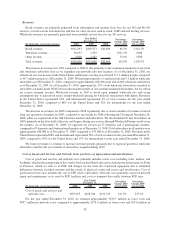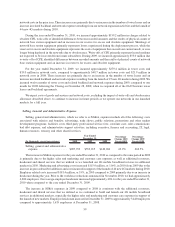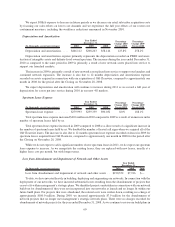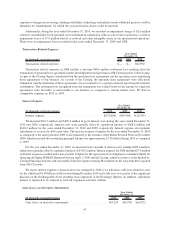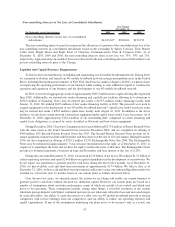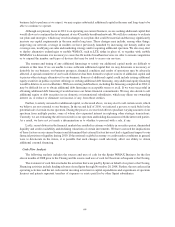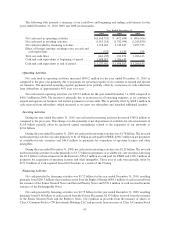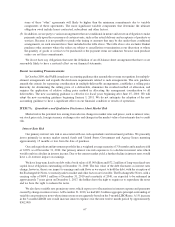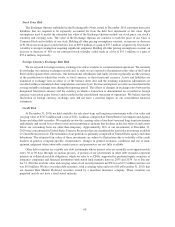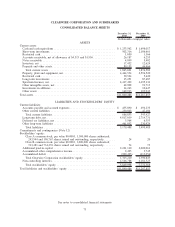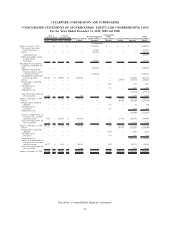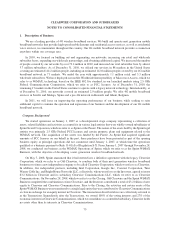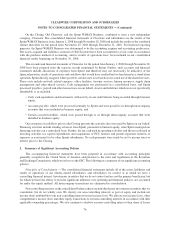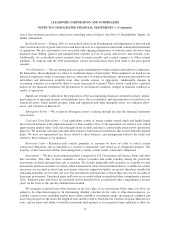Clearwire 2010 Annual Report Download - page 72
Download and view the complete annual report
Please find page 72 of the 2010 Clearwire annual report below. You can navigate through the pages in the report by either clicking on the pages listed below, or by using the keyword search tool below to find specific information within the annual report.some of these “other” agreements will likely be higher than the minimum commitments due to variable
components of these agreements. The more significant variable components that determine the ultimate
obligation owed include hours contracted, subscribers and other factors.
(5) In addition, we are party to various arrangements that are conditional in nature and create an obligation to make
payments only upon the occurrence of certain events, such as the actual delivery and acceptance of products or
services. Because it is not possible to predict the timing or amounts that may be due under these conditional
arrangements, no such amounts have been included in the table above. The table above also excludes blanket
purchase order amounts where the orders are subject to cancellation or termination at our discretion or where
the quantity of goods or services to be purchased or the payment terms are unknown because such purchase
orders are not firm commitments.
We do not have any obligations that meet the definition of an off-balance-sheet arrangement that have or are
reasonably likely to have a material effect on our financial statements.
Recent Accounting Pronouncements
In October 2009, the FASB issued new accounting guidance that amends the revenue recognition for multiple-
element arrangements and expands the disclosure requirements related to such arrangements. The new guidance
amends the criteria for separating consideration in multiple-deliverable arrangements, establishes a selling price
hierarchy for determining the selling price of a deliverable, eliminates the residual method of allocation, and
requires the application of relative selling price method in allocating the arrangement consideration to all
deliverables. The new accounting guidance is effective for fiscal years beginning after June 15, 2010. We will
adopt the new accounting guidance beginning January 1, 2011. We do not anticipate the adoption of the new
accounting guidance to have a significant effect on our financial condition or results of operations.
ITEM 7A. Quantitative and Qualitative Disclosures About Market Risk
Market risk is the potential loss arising from adverse changes in market rates and prices, such as interest rates,
our stock price risk, foreign currency exchange rates and changes in the market value of investments due to credit
risk.
Interest Rate Risk
Our primary interest rate risk is associated with our cash equivalents and investment portfolio. We presently
invest primarily in money market mutual funds and United States Government and Agency Issues maturing
approximately 15 months or less from the date of purchase.
Our cash equivalent and investment portfolio has a weighted average maturity of 3.8 months and a market yield
of 0.09% as of December 31, 2010. Our primary interest rate risk exposure is to a decline in interest rates which
would result in a decline in interest income. Due to the current market yield, a further decline in interest rates would
have a de minimis impact on earnings.
We have long-term fixed-rate debt with a book value of $3.90 billion and $72.2 million of long-term fixed-rate
capital lease obligations outstanding at December 31, 2010. The fair value of the debt fluctuates as interest rates
change, however, there is no impact to earnings and cash flows as we expect to hold the debt, with the exception of
the Exchangeable Notes, to maturity unless market and other factors are favorable. The Exchangeable Notes, with a
carrying value of $499.1 million at December 31, 2010 and a maturity of 2040, are expected to be redeemed in
approximately 7 years given on December 1, 2017, the holders have the right to require us to repurchase the notes
and we have the right to redeem the notes.
We also have variable rate promissory notes which expose us to fluctuations in interest expense and payments
caused by changes in interest rates. At December 31, 2010, we had $60.3 million aggregate principal outstanding of
variable rate promissory notes whose interest rate resets quarterly based on the 3-month LIBOR rate. A 1% increase
in the 3-month LIBOR rate would increase interest expense over the next twelve month period by approximately
$502,000.
67



